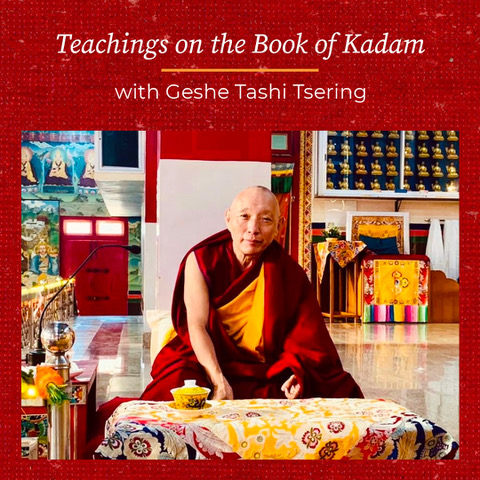In this series, Khen Rinpoche Geshe Tashi Tsering, abbot of Sera Mey monastery, gives a series of classes on a reading from The Book of Kadam, also known as The Miraculous Book of Kadam, attributed to Lama Atisha and Geshe Dromtönpa. He comments on Chapter 15 of The Jewel Garland of Dialogues: How to Train the Mind within the Expanse of Appearance, Emptiness and Empty Echoes.
As usual, Geshe Tashi’s style is part scholarly – he brings an exceptional depth of knowledge, experience and wisdom to the material; and a large part down to earth – how we can best apply these teachings to our everyday lives.
In this class, Geshe Tashi begins by explaining the meaning of the word Kadam, a name that reflects how closely the Kadampa Buddhists followed the Historical Buddha’s sutras as their main study and practice.
He explains how this particular chapter is part of the ‘Father Teachings’, named after the Tibetan father of this movement, ‘Father’ Dromtönpa. Based on Lama Atisha’s Jewel Garland of Dialogues, Geshe Dromtönpa asks Lama Atisha a series of practical, pithy and direct questions.
As Geshe la explains, Dromtönpa is praiseworthy for asking relevant, practical questions from the perspective of daily life. Does this seem like a familiar teaching style?!
Geshe la talks us through the chapter’s title, specifically the meaning of “Appearance”, “Emptiness” and “Empty Echoes”. Appearances both exist and have an impact, Geshe la points out, like the echo of a noise also has its impact.
Geshe la guides us through Dromtönpa’s questions, which begin with “What is the greatest fault for a practitioner?”, and lead us from attachment and aversion, as well as self-grasping, through to illusions and apparitions. In answer to Dromtönpa’s question on the difference between an illusion and an apparition, Lama Atisha tells the famous story of the man who dreams and lives another life.
Here Geshe la asks us to explore appearance and reality for ourselves as he takes us through this story of a dream that was “real”. It was real in that the experiences in the dream, the joy, sadness and all in-between, were real experiences. Those familiar with the Foundation of Buddhist Thought Course might remember how much of the course was devoted to this fundamental exploration of these two modes of reality. With this text and teaching, Geshe Tashi brings these teachings on the appearance and reality of our lives right back into the forefront of our minds.
As Geshe la says, this is a powerful story to help us question our belief in this modern world of ours, and our grasping to it. What is real and what is not real?
We hope you will continue down the rabbit hole with us for at least two more Sundays, as Geshe la continues to explore these fascinating teachings.
With best wishes,
The Admin Team
You can find details of upcoming classes as well as the text available for download here.
https://foundationsofbuddhistthought.org/

